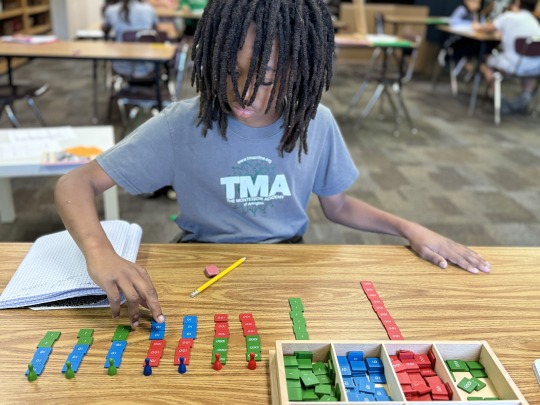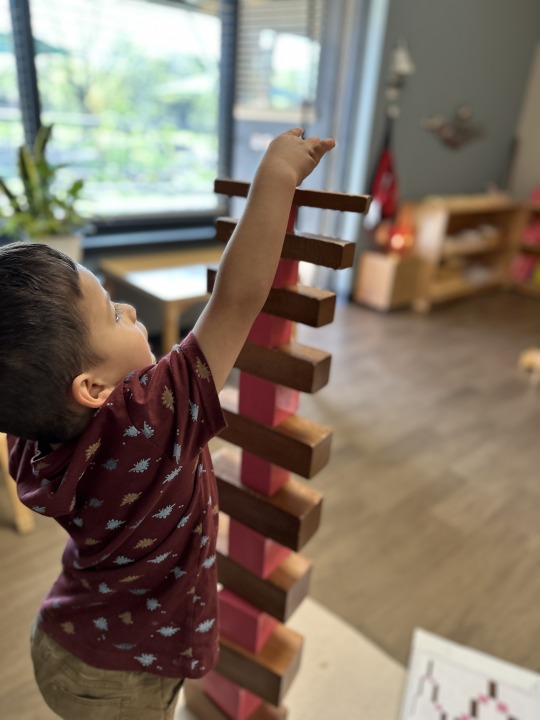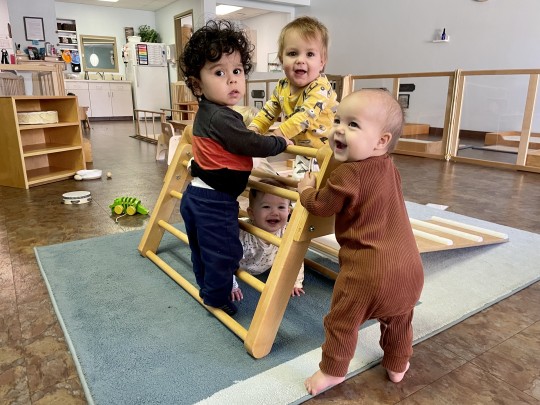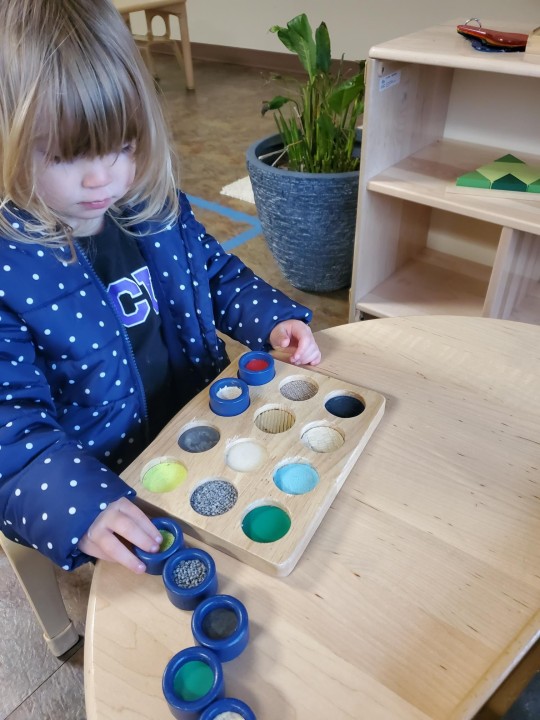#arlingontx
Explore tagged Tumblr posts
Text

Upper Elementary - Multi-Digit Division
Stories about foot, decurion, and centurion soldiers help to bring the “why” of multi-digit division to life for our math learners and capitalizes on the Elementary child’s powerful imagination. This student is using the Stamp Game material for his multi-digit division work which provides a hands-on, visual approach to understanding complex mathematical concepts. By using colored tiles to represent units, tens, hundreds, and thousands, students can physically manipulate and see the process of division unfold. This method helps to solidify their understanding of place value and the mechanics of division, making abstract concepts more concrete.
#math is fun#love of learnng#hands on learning#experiential learning#concrete to abstract#academically prepared#creative thinker#tma#montessori#private school#arlingontx#arlington#texas#infant#nido#toddler#early childhood#preschool#kindergarten#elementary#education#private education#nontraditional#the montessori academy of arlington
0 notes
Text

Early Childhood - Pink Tower and Brown Stairs
What a feat! This student has shown great patience and concentration when combining the Brown Stair and Pink Tower to create this amazing tower.
The Brown Stair is a constant attraction in the Montessori classroom and is frequently partnered with the Pink Tower. These materials share dimensional qualities of diminishing tenths that support the Base-10 system and the proportions of the base of each prism. While the Pink Tower teaches students about the relationship of size and weight, the Brown Stair teaches children to distinguish by thickness.
Children initially develop their visual and tactile discrimination by building the simple staircase with the Brown Stair material. After mastery, children explore other ways to lay out the Brown Stair, including aligning the thinnest prism in the space created between the height of each of the other stairs. Or they may discover some of the extensions that exist when they combine the stair and tower. There are many ways to build a tower, but only these materials together do so in a way that also reinforces the Base-10 number system and expands on the child's understanding of the relationships of dimension.
#brown stair#pink tower#visual discrimination#tactile discrimination#hands on learning#experiential learning#purposeful activity#concrete to abastract#order#concentration#coordination#independence#tma#montessori#private school#arlingontx#arlington#texas#infant#nido#toddler#early childhood#preschool#kindergarten#elementary#education#nontraditional#the montessori academy of arlington
0 notes
Photo

Early Childhood - Word Building
Our Montessori classroom is rich with language, from the casual conversations children enjoy between friends and teachers to the formal lessons in decoding, reading, and writing. Our language materials are quite simple with early materials introducing children to phonetic sounds. Later materials build upon those sounds to put together simple words.
The Moveable Alphabet is an early example of word-building, supporting children as they begin the arduous tasks of deconstructing ideas into the individual letters that comprise words. Children begin with accessible, three-letter phonetic words, sounding out each comprising part, identifying the letter in the box of moveable letters, and placing it in its appropriate place on the mat or table.
By beginning with just three letter words, children are able to see patterns in their own world-building, that consonants often precede vowels and vowels are usually followed by a second consonant. Building the words with the moveable alphabet pieces allows children to focus on the word rather than the formation of the letter shape with a pencil, so a child's understanding of word construction isn't limited by their fine motor control. As throughout our materials, even these alphabets focus on only the skill the child is learning, isolating that concept so that it can be fully mastered.
#word building#hands on learning#phonetics#word formation#order#concentration#coordination#independence#confident learner#competent learner#intrinsic motivation#tma#montessori#private school#arlingontx#arlington#texas#infant#nido#toddler#early childhood#preschool#kindergarten#elementary#educaiton#private education#nontraditional#the montessori academy of arlington
2 notes
·
View notes
Photo

Early Childhood - Science Experiments
Look at that focus! Early Childhood science experiences are more than just experiments! Our goal is to help build and foster a scientific mind, one that is inquisitive and wants to explore. Simple science tools, such as the Sink or Float Experiment, are part of the classroom curriculum. Not only is this student experimenting to see which items float, she is also strengthening her hands for future writing by using the tongs to pick up each item.
#science#experiments#hands on learning#experiential learning#inquisitive mind#exploration#scientific mind#fine motor skills#order#focus#concentration#coordination#independence#tma#montessori#private school#arlingontx#arlington#texas#infant#nido#toddler#early childhood#preschool#kindergarten#elementary#education#private education#nontraditional#the montessori academy of arlington
3 notes
·
View notes
Photo

Infant - Pikler Triangle
The design of the Pikler triangle is versatile, meeting the varying needs of an infant as their interests and mastery change so often. They can use it to climb up, pull to their knees, stand, and crawl underneath as well as climb on or over the ramp. The Pikler triangle satisfies a child's natural need to climb, aids in gross motor development and coordination, physical strength and agility, and encourages freedom of movement.
#pikler triangle#need to climb#gross motor development#coordination#physical strength#agility#freedom of movement#independence#always learning#hands on learning#capable#tma#montessori#private school#arlingontx#arlington#texas#infant#nido#toddler#early childhood#preschool#kindergarten#elememntary#education#nontraditional#the montessori academy of arlington
2 notes
·
View notes
Photo

Toddler - Sensorial Touch Board
The Sensorial Touch Board allows for sensory exploration and refinement. The child is invited to use their sense of touch and sight to differentiate between the textured, rough, or smooth surfaces and make a match.
#sensorial#hands on learning#sensory exploration#sense of touch#always learning#TMAstrong#tma#montessori#private school#arlingontx#arlington#texas#infant#nido#toddler#early childhood#preschool#kindergarten#elementary#education#nontraditional#the montessori academy of arlington
10 notes
·
View notes
Photo

Toddler - Shape Sorting Box
This work is intended to help a child discriminate shapes from each other by inserting them in the corresponding holes. They then retrieve them by sliding the door hiding the shapes, further reinforcing the concept of object permanence. However, before accomplishing this, the child must become familiar with the shapes themselves. They use their eyes and hands to explore each shape, and may even build with them to explore creativity and practice balance and hand-eye coordination.
#object permanence#hand eye coordination#visual discrimination#hands on learning#experiential learning#always learning#TMAstrong#tma#montessori#private school#arlingontx#arlington#texas#infant#nido#toddler#early childhood#preschool#kindergarten#elementary#education#private education#nontraditional#the montessori academy of arlington
1 note
·
View note
Video
tumblr
Early Childhood - Clock Work
This Kindergarten-age student noticed that the classroom had run out of the necessary papers for the Clock Work. He decided to make his own! He used another work, the metal insets, as a guide for the shape of the clock. He drew all 60 of the minute marks, along with everything else to make a clock face. This project showed independence, problem solving, autonomy, self-motivation, perseverance and many more traits of a Montessori student.
#independence#autonomy#self-motivation#perserverance#problem-solving#curiosity#creativity#intrinsic motivation#tma#montessori#private school#arlingontx#arlington#texas#infant#nido#toddler#early childhood#preschool#kindergarten#elementary#education#private education#nontraditional#the montessori academy of arlington
0 notes